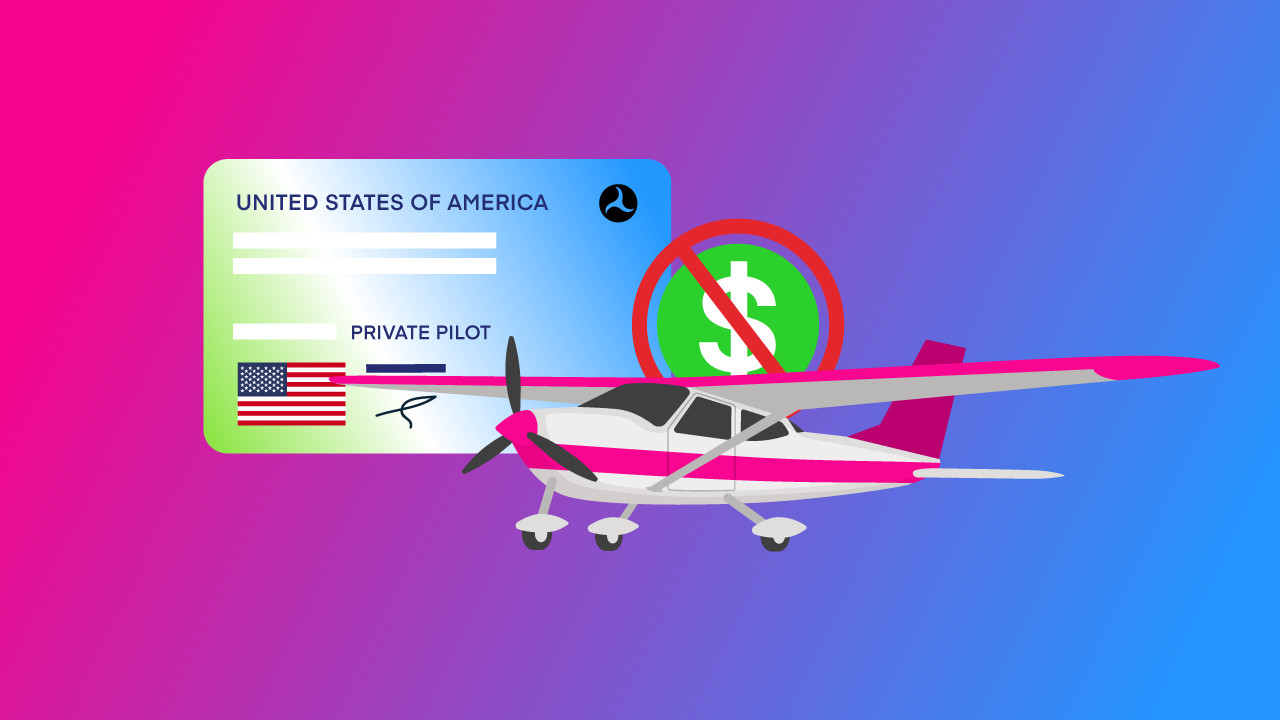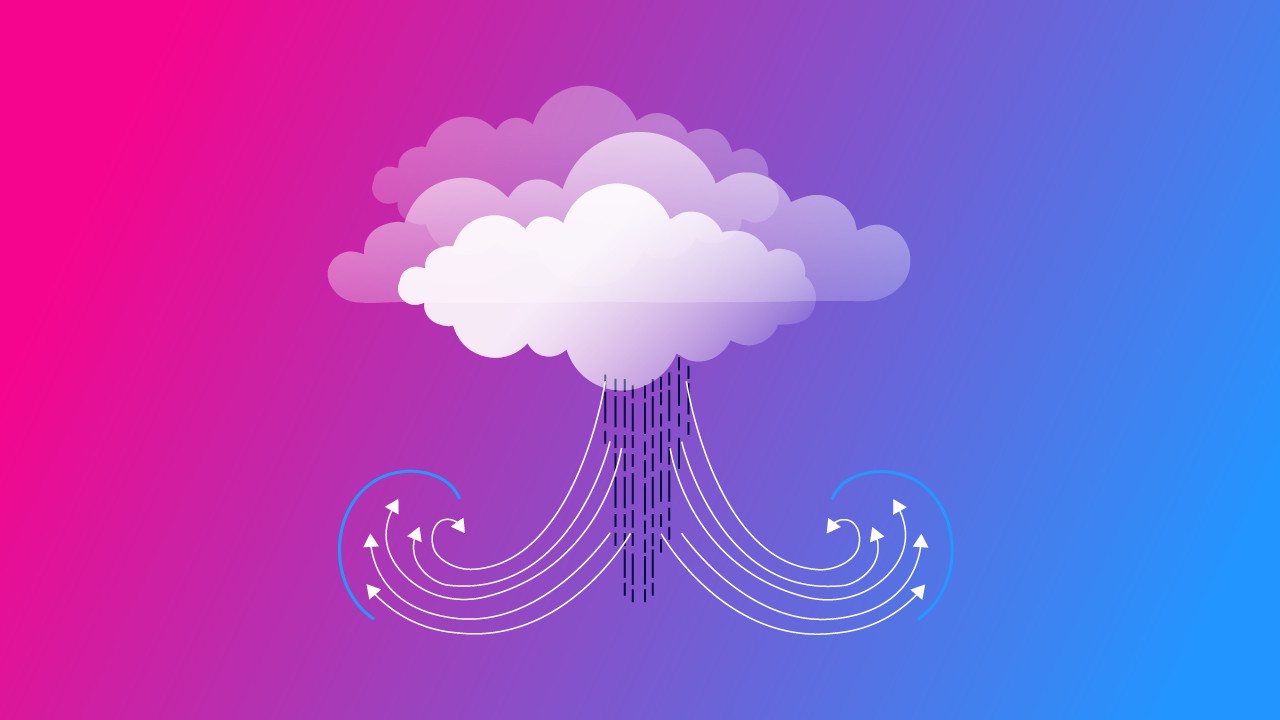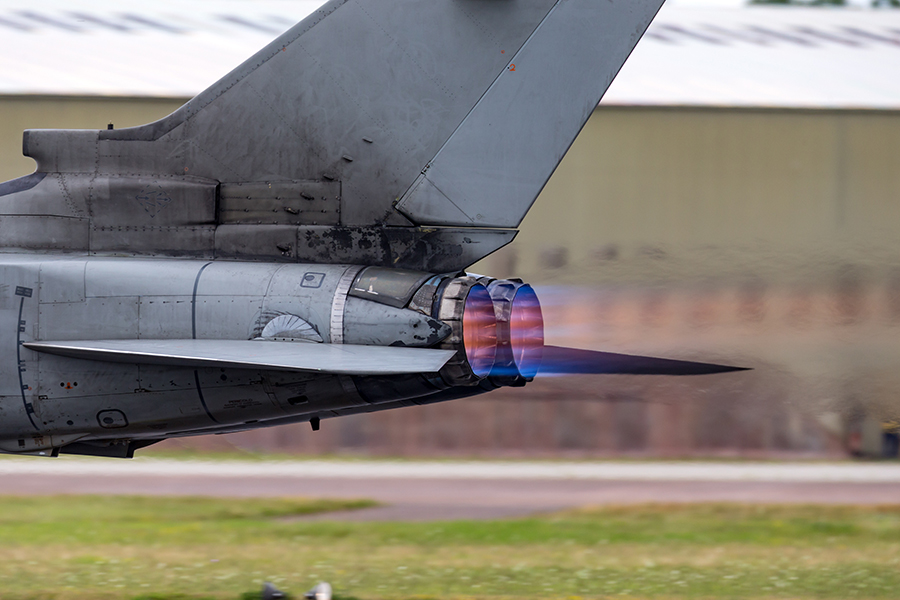-
Key Takeaways
-
A Quick Look
- Private Pilot Limitations
- Private Pilot Privileges
-
What Is a Private Pilot License (PPL)?
- A PPL Is a Stepping Stone
- Private Pilot License Requirements
-
Private Pilot Privileges
-
Important Pilot Terminology
- Airman Medical Certification
- CFR and FAR
-
FAA Regulations and Medical Certification
- The FAA Act of 1958
- Basic Certification Requirements
- Basic Med
-
Other Non-Commercial Pilot Licenses
- Higher Levels of License
-
CFR 91.146 – Passenger Carrying Flights for Non-Profits
- General
- Charitable Events
- Community Events
- Non-Profit Events
-
CFR 61.69 – Glider and Unpowered Ultralight Vehicle Towing
-
Search and Location Operations
-
Other Privileges that Come with a Private Pilot’s License
-
FAR 61.113: Pilot in Command Limitations and Privileges
-
Pilot Logbook
-
Category, Class & Endorsements
-
Conclusion
To become a pilot, you need 40 hours of flight time, be at least 17, pass a medical exam, and complete written and oral exams.
For many aviation enthusiasts, flying is a dream, a fantasy fueled by Superman, comics, and stories. A Private Pilot’s license can turn that dream into reality.
But with any license comes limits and responsibilities. This article will help you understand what a Private Pilot license allows, where it’s restricted, and how to use it responsibly.
While this guide is helpful, always check official FAA regulations or your flight school’s guidelines for the most accurate information.
Key Takeaways
- A Private Pilot License lets you fly passengers and at night, but not for pay.
- You need training, flight hours, a medical exam, and to pass FAA tests.
- Some limited paid activities are allowed, like charity flights and towing.
- You must stay medically fit with either an FAA medical or BasicMed.
A Quick Look
Before we dive in, let’s take a quick look at the different limitations and privileges we’ll be discussing.
Private Pilot Limitations
| Medical | Flight | Other things to consider |
| Must have a 3rd-class Medical Certificate or BasicMed. | Cannot fly for compensation or hire. Must follow airspace requirements applicable to all pilots. | You are allowed to fly with passengers, but cannot act as a pilot for hire or charge for your services. |
| Must not fly if you are aware of any medical condition that might impair your ability to fly. | Maintain continuous awareness of which airspace you are in. | You cannot act as a pilot for a business except in circumstances ‘incidental’ to the normal operation of that business. |
| Must renew and maintain your medical clearance at the appropriate interval. | You may only fly aircraft for which you have appropriate training and certifications. | |
| Must have your Medical fitness evaluated by an FAA Aviation Medical Examiner (AME). | You can only fly in conditions suited for Visual Flight Rules, unless you have an Instrument Rating. | |
Private Pilot Privileges
| Flight | Privileges |
| You are allowed to act as Pilot-in-Command (PIC) on flights conducted within your privileges. (see CFR 91.146) | On flights with passengers, you are allowed to ask for a pro-rata share of the operational costs of the airplane. |
| You are allowed to fly out of all public airports, including Class B. | You can participate in Search and Location operations and request reimbursement for operating costs. |
| You are allowed to fly at night | You may act as pilot-in-command to tow gliders and unpowered ultralight vehicles if you meet the requirements of FAR 61.69. |
| You are allowed to fly internationally, including to bordering nations, as long as you comply with each country’s entry and aviation procedures. | |
What Is a Private Pilot License (PPL)?
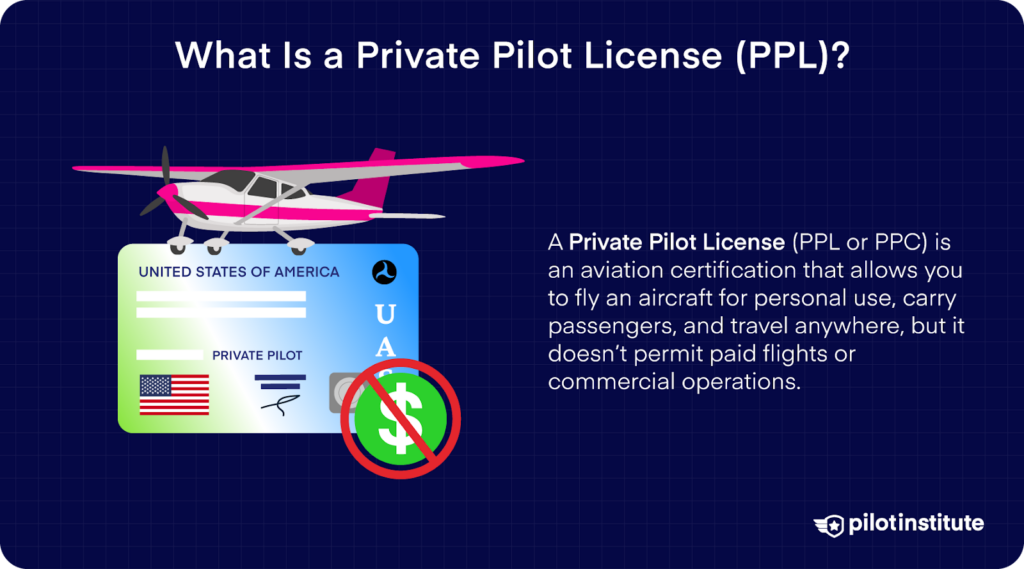
A Private Pilot License (PPL or PPC) is one of the several aviation certifications that allows you to operate certain types of aircraft for personal use.
But a Private Pilot license also limits the use of those aircraft and does not (generally) allow you to be paid as a pilot. We’ll talk about the exceptions later on.
A PPL Is a Stepping Stone
Most often, a Private Pilot license is obtained as one of the early stages of acquiring a higher-level license. There are a few reasons for this.
For one thing, getting your private pilot’s license usually requires a significant investment in schooling. You’ll need to pass a combination of written and practical tests to get this license. You’ll also need a logbook and have your flight log signed by a flight instructor.
Those opportunities are usually easiest to find in a flight school, although it is possible to work with a private instructor or take advantage of some other learning opportunities.
Another reason is that other license levels are suitable for those wishing to learn to fly as a recreational activity, and are cheaper and easier to get. Lower certification levels also tend to be easier to maintain than a Private Pilot license or higher.
There are many limitations placed on pilots with a Private Pilot license, but they also have more privileges than those with a recreational or sport license. We’ll get into more details later.
Private Pilot License Requirements
These are the requirements for a PPL:
- Flight Hours: Minimum 40 hours, including solo and instructional.
- Age and Medical Exam: At least 17 years old with a 3rd-class medical certificate.
- Exams: Written, oral, and practical tests.
- Training: Flight school or private instruction.
Private Pilot Privileges
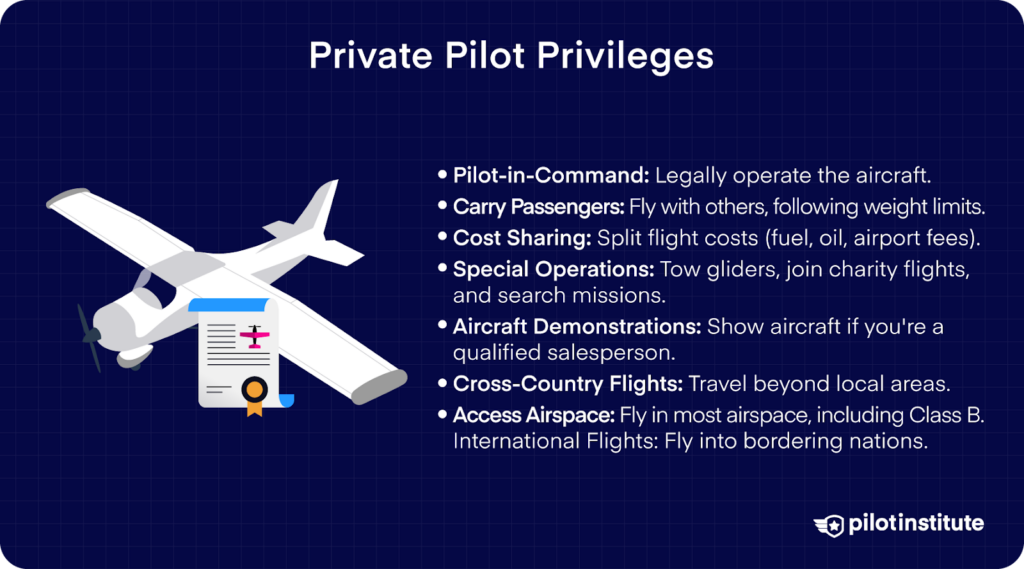
Being a private pilot provides certain privileges, such as:
- Act as Pilot-in-Command (PIC). (Note that 14 CFR 61.113 outlines limitations regarding compensation, and 14 CFR 91.146 details specific rules for acting as PIC for certain charitable, nonprofit, or community event flights)
- Pro-rata cost sharing with passengers.
- Flying out of all public airports, including Class B.
- Towing gliders and ultralight vehicles (if the requirements of FAR 61.69 are met).
- Participation in search and location operations with reimbursement for operating costs.
- Fly at night (having met the night training requirements for the PPL).
- Fly into other countries (must follow each country’s entry requirements).
- Participate in community, charitable, or non-profit events under specific conditions (per FAR 91.146).
Important Pilot Terminology
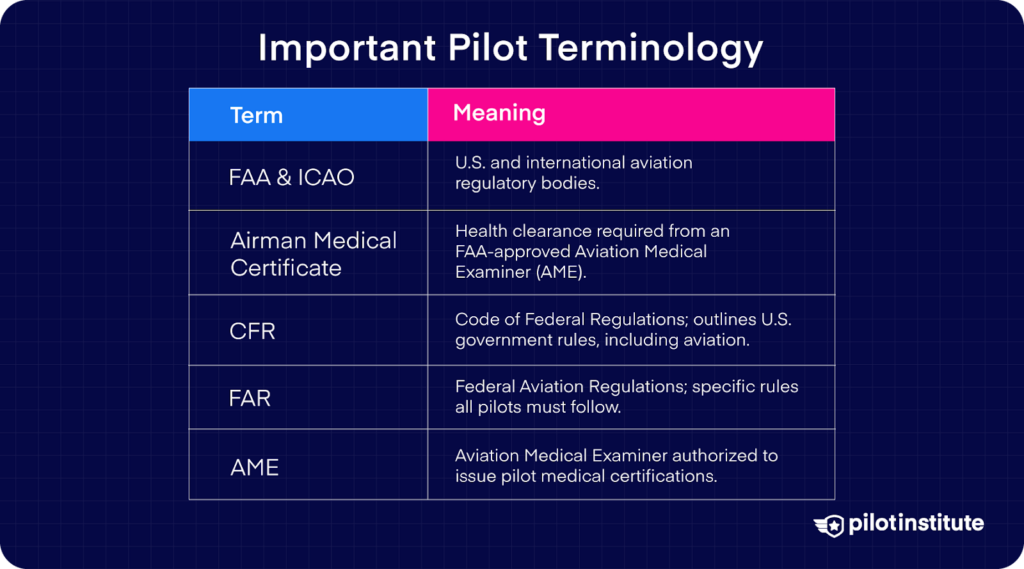
While we can’t go into every regulation, privilege, and limitation in-depth, there is some terminology you’ll need to know if you want to get your private pilot’s license and to understand the existing regulations.
We’ve already covered some, like FAA and ICAO, but here are a few more. These will help translate this, and other articles, outlining your pilot’s privileges and limitations.
Airman Medical Certification
These certifications are regulated by the FAA and specifically by the Federal Air Surgeon. They must be performed by an FAA-approved Aviation Medical Examiner (AME) and have a strict set of requirements candidates must meet in order to qualify.
CFR and FAR
These acronyms refer to the regulations governing aviation. CFR stands for the Code of Federal Regulations, and FAR, short for Federal Aviation Regulations, is a subset found in Title 14 of the CFR. As a pilot, you must follow the regulations that apply to your certification level.
With additional privileges usually come additional regulations, so you will need to keep more of these regulations in mind with a Private Pilot license than you would with a Recreational or Sport license.
FAA Regulations and Medical Certification
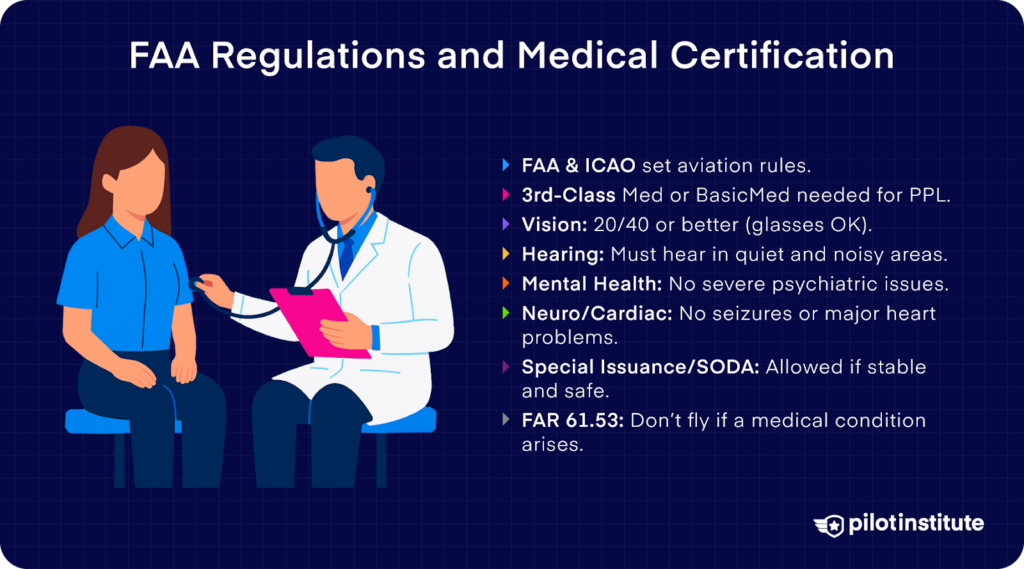
The regulations on Private Pilot licenses come from a number of sources. In the U.S. the highest authority is the FAA, the Federal Aviation Administration.
There is also a larger international aviation body, the International Civil Aviation Organization (ICAO), which helps standardize requirements across the different national aviation regulatory bodies.
These basic medical requirements should be met as soon as possible. If it turns out you aren’t medically eligible for the license level you want, it is possible to appeal in some cases and get some exceptions. Generally, however, exceptions aren’t given.
It’s much better to know ahead of time if you’ll be able to get your license, preferably before you’ve spent a bunch of money working on it. This is one of the most important limitations that come with your private pilot’s license, so we’re going to spend some time exploring it.
The FAA Act of 1958
This act is important because it outlines the government’s responsibility both to promote aviation itself and to support safety within aviation.
One of the goals of the FAA Act of 1958 was to help streamline the medical approval process, and to create more urgency behind regulations that protect pilots, passengers, and the general public. After all, aviation is not risk-free, despite the many assists modern technology and better training have given us.
Despite the goal of streamlining, medical approval can take quite a while. The system is often bogged down, and there may be clerical and bureaucratic errors along the way. We mention it because you should plan some extra time in the medical approvals stage.
Basic Certification Requirements
Since we’re focusing on the Private Pilot license, we’ll cover the 3rd class medical certificate, which is typically required for this license. We’ll also touch on BasicMed, an alternative option available to some pilots.
As per FAA regulations, the validity of a third-class medical certificate depends on the pilot’s age.
- Under 40 Years Old: Valid for 60 months (5 years).
- 40 Years and Older: Valid for 24 months (2 years).
Let’s break down the types of medical requirements expected for the 3rd-class medical.
1. Visual Requirements
We’ll start with the requirements and then explain them.
- Must have 20/40 vision or better, with or without corrective lenses.
- Must perceive the full range of aviation-related colors. Red-green color vision deficiency doesn’t automatically disqualify a pilot, but it may limit them to daytime-only flying and restrict use of light gun signals.
- Eyes are assessed for structural or functional issues (e.g., poor depth perception, internal eye pressure) that could impair flight, subject to the AME’s judgment.
The most basic vision requirement of the 3rd class medical certification is that you have 20/40 vision. You can use corrective lenses, either glasses or contacts, to achieve that level of vision. But your visual acuity must also be consistent.
You also need to be able to see the full range of colors used in aviation. While some types of colorblindness may not be prohibitive, red/green colorblindness, the most common variety, usually is.
Additionally, your eyes will need to be evaluated for other structural or functional problems that may interfere with flight or may get worse while flying. These requirements aren’t well defined, partially because they fall under the jurisdiction and judgment of the Aviation Medical Examiner.
For instance, poor depth perception or internal eye pressure issues might be considered disqualifying, but may depend on the severity.
2. Auditory Requirements
Much like vision, there are some auditory requirements for safe flight as a pilot.
- Must hear a conversation with your back turned at 6 feet in a quiet room.
- May be tested in noisy environments or with one ear covered.
- Must have no conditions affecting the ears, nose, throat, or balance that could impair communication or cause vertigo in flight.
Tests of auditory acuity include listening to a conversation in a quiet room with your back turned to the speaker(s), while at least 6 feet away. You might also be asked to demonstrate the ability to hear in a noisy situation, or with one ear covered.
In both cases, a certain level of accuracy is required.
Like vision, it’s also required that there be no disease of malfunction of the entire auditory system, including the middle and inner ear, nose, oral cavity, pharynx, and larynx, which impairs the ability to fly. You similarly cannot have a condition in any of these areas that might be aggravated by flying.
You must always be able to maintain clear and effective audible communication.
You cannot have any condition likely to cause vertigo or any other loss of spatial awareness.
3. Mental Requirements
Because of the responsibility and stress load of acting as a pilot, there are some fairly strict mental requirements you must meet as well.
Disqualifying diagnoses include:
- Severe personality disorders.
- Psychosis, hallucinations, delusions.
- Bipolar disorder.
- Use of medication does not override disqualification.
Substance abuse or dependence (past or present) is also disqualifying.
You can’t have been diagnosed with a personality disorder severe enough to cause overt abnormal behavior and acts.
You also can’t have ever been diagnosed with psychosis, hallucinations, delusions, or disorganized behavior.
Similarly, you can’t have been diagnosed with bipolar.
Medication and other therapeutic interventions for these disorders will not make you eligible for 3rd class medical certification. The diagnosis by itself is prohibitory regardless of treatment.
Additionally, you cannot have any substance use disorders. Your doctor will test for physical evidence of various possible dependencies, ask you questions about your substance use, including legal substances like alcohol, and also look at your medical history for documentation of any past dependencies.
4. Neurological Requirements
Neurological disorders are trickier, and many are disqualifying for pilot’s licenses, including the private pilot’s license.
- Conditions like epilepsy or seizure disorders are not permitted.
- Any unexplained loss of consciousness or temporary neurological dysfunction may disqualify you, especially if the condition is chronic or likely to recur.
- Exceptions may be made at the discretion of the Federal Air Surgeon.
For the 3rd class of medical certification, you cannot have epilepsy. Generally, you cannot have other seizure disorders or disorders that can cause seizures, either.
You cannot have experienced a temporary loss of nervous function, of any variety, without a medically explainable condition. Said condition must also be acute, rather than chronic. Chronic conditions are likely to be disqualifying.
Similarly, you cannot have experienced a loss of consciousness without having a medical explanation of its cause. Like conditions affecting other nervous functions, the loss of consciousness cannot be caused by a condition that is chronic or likely to recur.
There can be exceptions or additions here, at the discretion of the Federal Air Surgeon. But, in general, any nervous condition that might, even temporarily, impair your ability to safely pilot an aircraft would be disqualifying.
5. Cardiovascular Requirements
Heart health is one of the most important factors for a pilot. You may not qualify if you’ve had:
- Heart attack (myocardial infarction).
- Angina or serious coronary heart disease.
- Heart valve replacements or transplants.
- A pacemaker.
In order to meet the cardiovascular requirements, you cannot have had a myocardial infarction, angina pectoris, or coronary heart disease severe enough to require treatment or to present significant symptoms.
You also cannot have had a heart valve replacement or a heart transplant. Pacemakers are not allowed.
6. General Requirements
In addition to all the other health requirements, the Federal Air Surgeon may also disallow medical certifications based on other conditions.
Diabetes that requires medical treatment via insulin or other blood-sugar-lowering medications is also disallowed.
FAR 67.401: Special Issuance of Medical Certificates
In some circumstances, it is understood that a pilot may be perfectly qualified to fly while also having a condition that would normally disqualify them from medical certification.
This regulation allows the Federal Air Surgeon to make exceptions and issue time-limited medical certifications to pilots, including pilots pursuing their private pilot’s license or seeking to renew their existing medical certification.
Usually, this is done in cases where there is a chance that the pilot is still competent and safe to be in the air. The temporary special issuance allows the pilot to be tested for continued competence and ability despite their medical condition.
It does not have to be issued under any circumstances. It’s a discretionary option, not a regular part of the process of evaluating candidates who may not meet medical requirements.
Statements of Demonstrated Ability (SODA)
Statements of Demonstrated Ability work as a separate kind of medical certification. SODAs acknowledge that the pilot has a medical condition that could impact their ability to fly, but that the pilot has demonstrated that the condition does not prevent them from safely operating an aircraft.
It can be issued for whatever certification level is necessary. But, like the special issuance of medical certificates, SODAs are not necessarily standard, and not every pilot or candidate who requests to be evaluated for one will be.
FAR 61.53: Prohibition on Operations During Medical Deficiency
Medical certification details matter because FAR 61.53 prohibits pilots from flying if their medical condition changes and disqualifies them.
Once certified, you must monitor your health and stop flying if you develop a disqualifying condition until cleared by an FAA-authorized doctor.
Temporary issues, like intoxication or needing new glasses, require grounding until resolved. More serious conditions, such as diabetes or heart disease needing treatment, may cause longer-term disqualification. Pilots are responsible for following these rules.
Basic Med
BasicMed is an FAA option that lets eligible pilots fly without a current FAA medical certificate. To qualify, you must have held an FAA medical after July 15, 2006, hold a valid driver’s license, complete a medical exam with a regular doctor every 48 months, and finish an online FAA course every 24 months.
BasicMed allows:
- Flying aircraft with a maximum takeoff weight (MTOW) of up to 12,500 pounds.
- Carrying no more than 6 passengers (7 total occupants including the pilot).
- Flying at or below 18,000 feet MSL.
- Flying at 250 knots indicated airspeed (IAS) or less.
- Not for compensation or hire; BasicMed cannot be used for commercial operations.
Other Non-Commercial Pilot Licenses
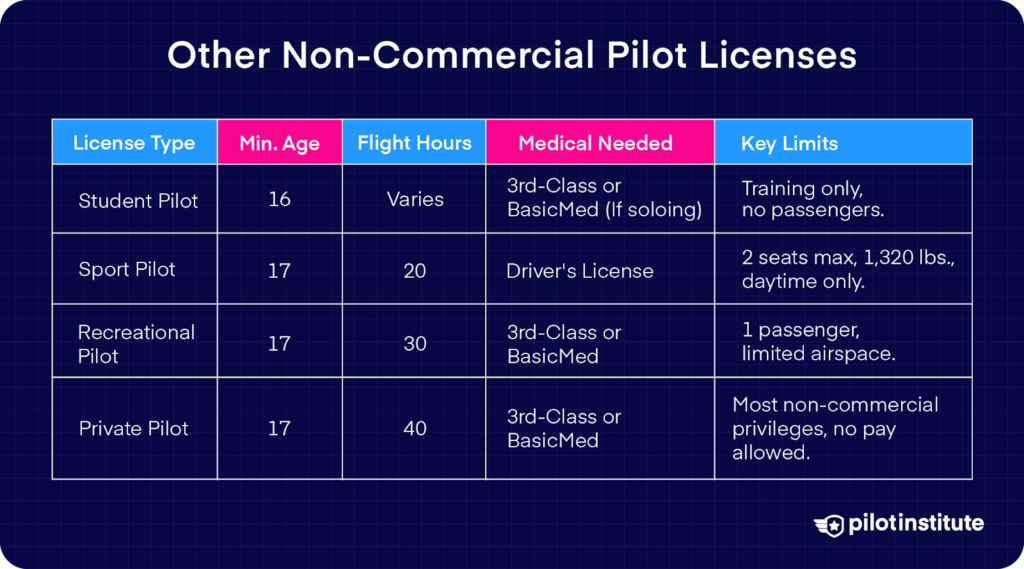
While these aren’t specifically related to the Private Pilot license, it’s worth looking at other types of pilots’ licenses for comparison. When it comes to non-commercial licenses, the Private Pilot license is currently the highest level.
Sport Pilot License
This is a new form of pilot license that is designed for people who are looking to fly something larger than an ultralight or a glider, but who are not interested in pursuing a higher license level or are unable to get that higher license level.
One of the biggest differences between a Sport Pilot license and the other forms of license on this list is that it doesn’t require an FAA medical certificate. If you are medically able to drive a car and have a current, valid driver’s license, you are eligible for a Sport Pilot license.
You are significantly more limited with this license. You can only fly aircraft with a maximum of 2 seats, and your aircraft cannot exceed 1,320 lbs. at takeoff and landing (on land).
However, it only requires 20 hours of flight time before certification.
Recreational Pilot License
This is the license one step down from the Private Pilot license. It requires 30 hours of flight training at a minimum. Recreational Pilots are required to get and maintain the same 3rd-class Airman’s Medical Certification as the Private Pilot license.
With this license, pilots are usually only allowed to fly aircraft with one passenger. They are not given the same privileges that come with the Private Pilot license in terms of other types of flight, but have a few more freedoms than a Sport license.
Student’s Pilot License
This license needs to be earned in order to start logging solo flight time. It’s also the only license on this list that can be earned before the potential pilot turns 17. A student license can be earned at 16, assuming all the other requirements have been met.
All other pilots’ licenses require the pilot to be at least 17 years old.
Higher Levels of License
After you acquire your Private Pilot License, you can pursue advanced certifications like the Commercial Pilot License, Airline Transport Pilot License, or Flight Instructor Certificate. These licenses require more flight time, additional training and testing, and sometimes a college degree.
Most higher licenses eventually require a higher-level medical to exercise full privileges, but only a 3rd class medical (or BasicMed) is needed to take the practical tests.
For example, Certified Flight Instructors (CFIs) only need a 3rd class medical or BasicMed to teach.
CFR 91.146 – Passenger Carrying Flights for Non-Profits
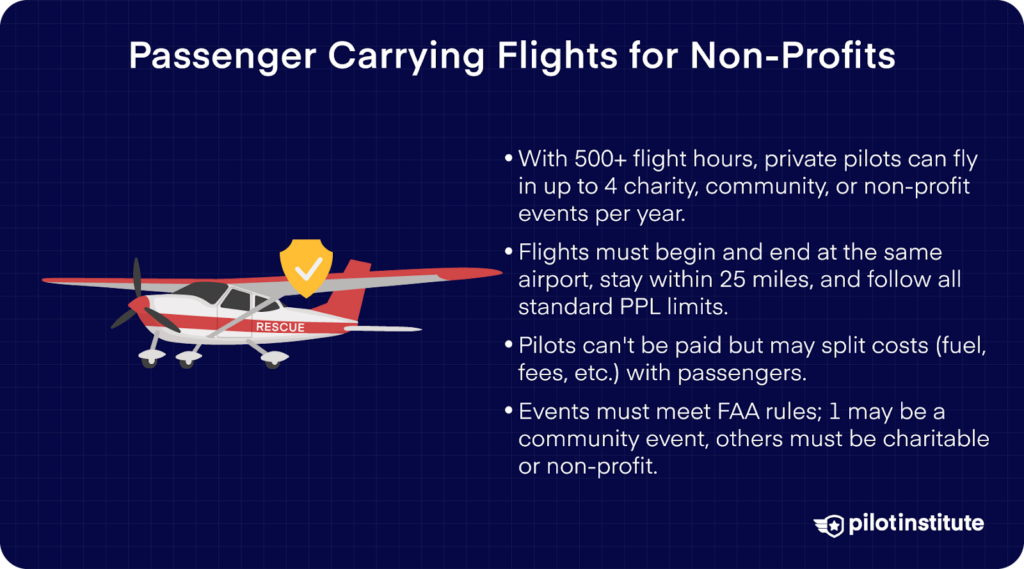
As a private pilot, you can legally carry passengers for charitable, nonprofit, or community events under CFR 91.146—but there are rules. You’ll need FAA approval ahead of time, and you can’t get paid (except to cover basic operating costs).
The flight has to be nonstop, stay within 25 nautical miles, and begin and end at the same airport. You also need at least 500 hours of total flight time, and the aircraft must meet all maintenance and airworthiness requirements. No aerobatics or formation flying allowed.
You can even carry passengers on these flights, so long as you abide by your aircraft limits, the other restrictions of the private pilot’s license, and aren’t paid to act as a pilot.
Let’s get further into the details.
General
With a private pilot’s license, you’re limited to flying for up to 4 of these events in a calendar year. None of the events can last more than 3 days, or at least, your services as a pilot cannot last more than 3 days.
You cannot be paid as a pilot.
For flights conducted under 14 CFR 91.146, the pilot volunteers their services. The sponsoring organization may reimburse the pilot for actual operating expenses (such as fuel, oil, airport expenditures, and rental fees). The pilot is not required to pay a pro-rata share of the flight costs in this specific context.
You must have your actual pilot certificate, medical certification, and flight logbook with you.
A private pilot’s license does not authorize you to perform formation flight or aerobatic displays.
Similarly, the flight must start and end at the same airport, and, unless authorized by the FAA, you cannot fly over a national park, unit of a national park system, national wildlife refuge, or an identified wilderness area designated by Federal law during these event flights. The aircraft may not have more than 30 seats, excluding crewmember seats.
The entire flight must take place within 25 miles of the airport.
Every aircraft involved must be certified as airworthy.
Charitable Events
Eligible charitable events include any event put on by a charity recognized under section 170 of the Internal Revenue Code.
Eligible charities should be able to prove this status.
All of the normal regulations concerning flights conducted with a private pilot’s license remain in place.
Community Events
Community events fall under basically the same requirements as charities, excepting that they don’t need to qualify for any specific legal designation. As long as the community event is designed to benefit some local cause, it may be considered eligible for a pilot holding a private pilot’s license.
However, a private pilot license only allows you to work as a pilot for 1 community event per year. So, of 4 possible events, you may work as pilot per year, the other 3 must be either charity or non-profit events.
Non-Profit Events
Non-profit events are a little more regulated. The non-profit must be recognized by some Federal or State Authority, although the specific type of non-profit is not regulated.
The one specific requirement of a non-profit event is that the non-profit must include the promotion of aviation safety in its organizational purposes.
CFR 61.69 – Glider and Unpowered Ultralight Vehicle Towing
You are allowed to tow a glider or unpowered ultralight vehicle as a private pilot, but FAR 61.69 requires additional training, endorsements, and recent towing experience. This includes at least 100 hours as PIC in the aircraft category/class, specific training and endorsements, and currency requirements to legally tow.
Search and Location Operations
Private pilots may volunteer for search and location operations. While you can be reimbursed for operating costs during these missions, this activity does not grant any special privileges beyond those already allowed under a private pilot certificate.
You can be reimbursed for your costs—including fuel, oil, and other operational expenses—only when participating in a search and location operation that is sanctioned and under the direction of a local, state, or federal agency, or a qualified search and location organization.
Other Privileges that Come with a Private Pilot’s License
In addition to the rights of a sports and recreational pilot, a Private Pilot gets a few additional privileges, while others are expanded.
For instance, Recreational Pilots are limited by 14 CFR 61.101(e)(5) from acting as pilot in command of an aircraft at an altitude of more than 10,000 feet MSL or 2,000 feet AGL, whichever is higher. Sport Pilots also typically operate below 10,000 feet MSL due to LSA operational limitations and airspace rules.
There is no altitude restriction with the Private Pilot certificate, other than Class A airspace at 18,000 feet requires you to have an Instrument Rating.
With a Private Pilot License, you’re allowed to fly at night and into Class B airspace, privileges not available to Sport or Recreational pilots.
You can also fly internationally, but you must follow all applicable regulations of the destination country, which may include notifying their aviation authority or meeting additional entry requirements.
FAR 61.113: Pilot in Command Limitations and Privileges
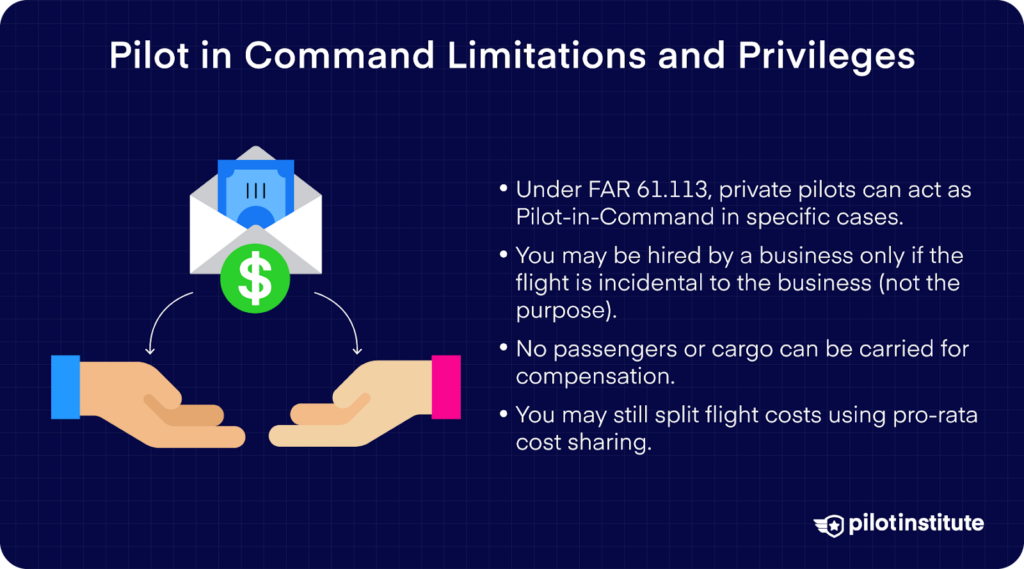
One of the biggest differences between lesser licenses and the private pilot’s license is this. Under FAR 61.113, there are specific circumstances in which you, the pilot, may now act as the Pilot-in-Command of a flight.
Under the right circumstances, you can also be paid for your services as a pilot. These circumstances are highly specific, however, and do still prohibit you from making a business as a commercial pilot.
For example, Under FAR 61.113(b), a private pilot can act as pilot in command for compensation. This applies if the flight is just a small part of their business or job. They cannot carry passengers or property for payment.
If the flight is in any way central to the business, such as air tours or promotional flights, it is not permitted under a private pilot certificate. When in doubt, consult with an aviation attorney.
Pilot Logbook
As a private pilot, you are required to keep an up-to-date and certified logbook of your flights and flight times. This includes logging flights to meet requirements for carrying passengers (FAR 61.57) and ensuring you complete and log a flight review every 24 months (FAR 61.56).
Category, Class & Endorsements
Private pilots are certified to fly aircraft in specific categories and classes, such as Airplane Single-Engine Land (ASEL). Unlike recreational pilots, they are not restricted by seat count or horsepower limits, except under BasicMed.
As you continue your training, you may earn additional endorsements (like complex, high-performance, tailwheel, or high-altitude) and category/class ratings based on your goals and the aircraft you wish to fly. These endorsements allow you to legally operate more advanced or specialized aircraft types.
You may also fly aircraft you’re not yet rated for while receiving dual instruction from an authorized instructor, as long as you’re under their supervision and meeting training requirements for the new certification.
Conclusion
A Private Pilot License (PPL) lets you fly for fun. It gives you the freedom to explore the skies and share adventures with passengers.
But it comes with responsibilities. As a private pilot, know your rights and limits. Also, keep your medical certification up to date.
Always stay aware of FAA regulations, fly within your training, and focus on safety. A PPL is just the beginning of your journey in aviation. Use it wisely and continue learning.
